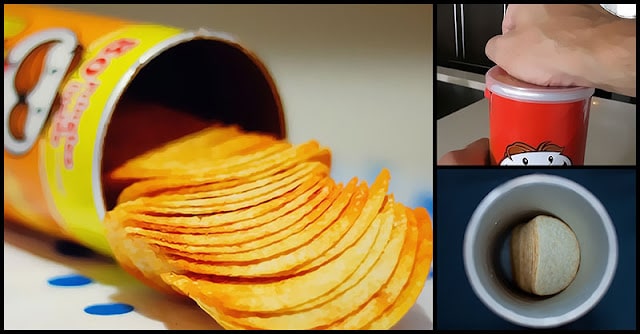Understanding the nature of Pringles as well as other stackable chips will make you forget that they are made from actual potatoes in any recognizable way.
According to the Pringles Company, the content of potatoes in their chips was so small that they are technically not even a potato chip. The company stated this in an effort to avoid taxes levied against “luxury foods” like chips in the UK.
So, Potato Chips Are Exactly Made Of What?
It starts with a slurry of rice, potato flakes, corn, and wheat which are pressed into shape. This dough-like substance is then rolled out into an ultra-thin sheet cut into thin chip-cookies by a machine.
According to io9:
“The chips move forward on a conveyor belt where they’re pressed onto molds, that gives them the curve that helps them fit into one another. Those molds move through boiling oil … Then are blown dried, sprayed with the powdered flavors, and at last, placed onto a slower-moving conveyor belt specially made allowing them to stack. After that, they go into the cans … and off to the innocent mouths of the consumers.”
For sure, many of you enjoy the taste of potato chips. Unfortunately, they are one of the most toxic processed foods you can eat.
Potato Chips Are Loaded With Cancer-Causing Chemicals
A hazardous ingredient found in potato chips is not intentionally added, but instead a byproduct of the processes involved in making it.
Acrylamide, a cancer-causing, and potentially neurotoxic chemical are created when carbohydrate-rich foods are cooked at high temperatures, whether roasted, fried, toasted or baked. The worst examples of these foods are potato chips and French fries. Also, food is likely to contain acrylamide if it is cooked or processed at temperature above 212°F (100°C). Here is the rule: acrylamide is formed when the food is heated enough to produce a fairly dry and yellow/brown surface.
Hereby, it can be found in:
Potatoes: Chips, French fries, and other fried or roasted potato foods
Grains: roasted breakfast cereals, toasted bread crust, crisp bread, and various processed snacks.
How Much Acrylamide Are You Consuming?
In drinking water, the federal limit for acrylamide is 0.12 micrograms in an eight-ounce glass of water or about 0.5 parts per billion. However, consuming a six-ounce serving of French fries will give you 60 micrograms of acrylamide or about five hundred times over the federal limit.
Potato chips have higher amounts of this hazardous chemical. In fact, in 2005, the potato chips makers were sued by the state of California due to their failure to warn the consumers from California regarding the health risk of acrylamide found in their products. It was in 2008 when an agreement was made by Frito-Lay and few other potato chips makers. They agreed to reduce the acrylamide levels in their chips to 275 parts per billion (ppb) by 2011, which is the amount low enough to avoid the cancer warning label.
The California-based Environmental Law Foundation (ELF) warned the public about the dangers of this popular snack through their 2005 report “How Potato Chips Stack Up: Levels of Cancer-Causing Acrylamide in Popular Brands of Potato Chips.” The result of their analysis showed that all potato chip products tested were over the legal limit of acrylamide by a minimum of 39 times, and a maximum of 910 times!
Acrylamide Is Not The Only Danger
Aside from acrylamide, another dangerous genotoxic compound is formed when foods are heated to high temperature.
Results of a three-year EU project, known as Heat-Generated Food Toxicants (HEATOX), found that there are more than 800 heat-induced compounds, of which 52 are potential carcinogens. In addition to acrylamide, scientists also found that you are far less likely to ingest dangerous levels of the toxin when you eat homecooked foods compared to the restaurant or industrially-prepared foods.
It was also suggested by the HEATOX findings that although there are ways to decrease exposure to acrylamide, it can never be eliminated completely.
Just remember that cooking food at high temperatures is not advised. A few of the most well-known toxins created in high-temperature cooking include:
Heterocyclic Amines (HCAs)
These HCAs are formed when the meat is cooked at high temperatures, and they’re also linked to cancer. When it comes to HCAs, the worst part of the meat is the section where the meat has blackened, that’s why you should always avoid charring your meat, and never eat the blackened sections.
Advanced Glycation End Products (AGEs)
The formation of AGEs in your food increases when the food is cooked at high temperature (including when it is sterilized or pasteurized). The AGEs transfer to your body when you eat the food. When it accumulates in your body, it can lead to oxidative stress, inflammation, and an increased risk of kidney diseases, diabetes, and heart diseases.
Polycyclic Aromatic Hydrocarbons (PAHs)
Fats dripping onto the heat source causes excess smoke, which surrounds your food and transfers cancer-causing PAHs in the meat.
How To Avoid Heat-Induced Toxins In Your Diet?
It would be better if you consume foods that are raw or minimally processed if you really want to avoid these types of toxic byproducts. Though it may take you some time to switch over to a less processed diet, however, it would be a great start if you throw out the most obvious culprits – potato chips and French fries, doughnuts, and all kinds of sodas (both regular and diet, as artificial sweeteners may be more problematic than fructose).









